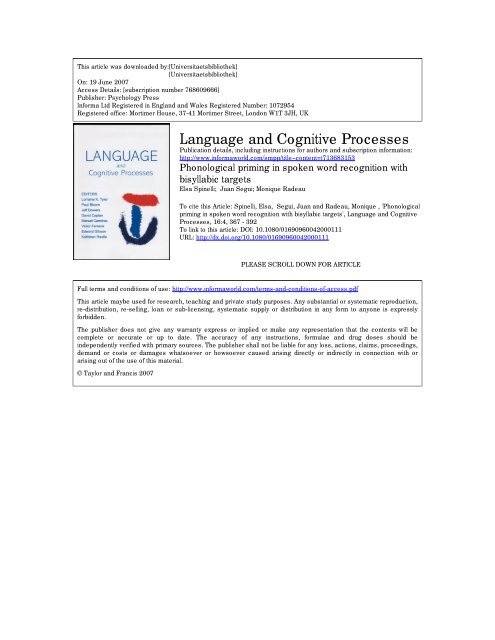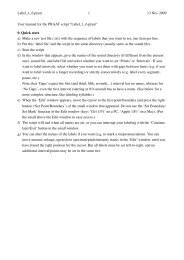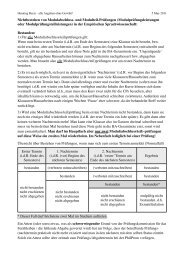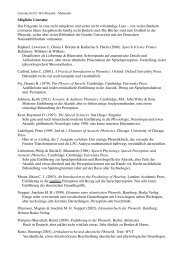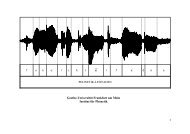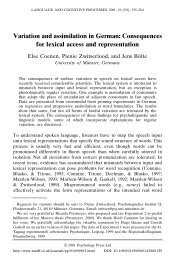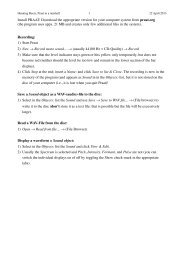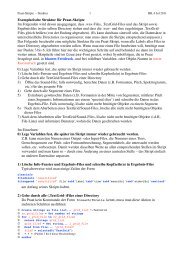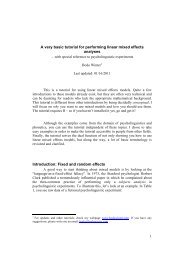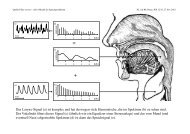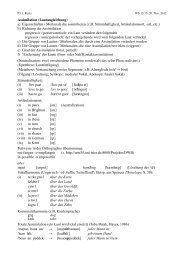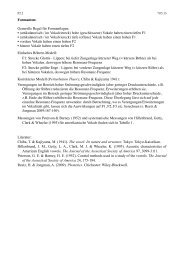Language and Cognitive Processes - Institut für Phonetik
Language and Cognitive Processes - Institut für Phonetik
Language and Cognitive Processes - Institut für Phonetik
Create successful ePaper yourself
Turn your PDF publications into a flip-book with our unique Google optimized e-Paper software.
This article was downloaded by:[Universitaetsbibliothek]<br />
[Universitaetsbibliothek]<br />
On: 19 June 2007<br />
Access Details: [subscription number 768609666]<br />
Publisher: Psychology Press<br />
Informa Ltd Registered in Engl<strong>and</strong> <strong>and</strong> Wales Registered Number: 1072954<br />
Registered office: Mortimer House, 37-41 Mortimer Street, London W1T 3JH, UK<br />
<strong>Language</strong> <strong>and</strong> <strong>Cognitive</strong> <strong>Processes</strong><br />
Publication details, including instructions for authors <strong>and</strong> subscription information:<br />
http://www.informaworld.com/smpp/title~content=t713683153<br />
Phonological priming in spoken word recognition with<br />
bisyllabic targets<br />
Elsa Spinelli; Juan Segui; Monique Radeau<br />
To cite this Article: Spinelli, Elsa, Segui, Juan <strong>and</strong> Radeau, Monique , 'Phonological<br />
priming in spoken word recognition with bisyllabic targets', <strong>Language</strong> <strong>and</strong> <strong>Cognitive</strong><br />
<strong>Processes</strong>, 16:4, 367 - 392<br />
To link to this article: DOI: 10.1080/01690960042000111<br />
URL: http://dx.doi.org/10.1080/01690960042000111<br />
PLEASE SCROLL DOWN FOR ARTICLE<br />
Full terms <strong>and</strong> conditions of use: http://www.informaworld.com/terms-<strong>and</strong>-conditions-of-access.pdf<br />
This article maybe used for research, teaching <strong>and</strong> private study purposes. Any substantial or systematic reproduction,<br />
re-distribution, re-selling, loan or sub-licensing, systematic supply or distribution in any form to anyone is expressly<br />
forbidden.<br />
The publisher does not give any warranty express or implied or make any representation that the contents will be<br />
complete or accurate or up to date. The accuracy of any instructions, formulae <strong>and</strong> drug doses should be<br />
independently verified with primary sources. The publisher shall not be liable for any loss, actions, claims, proceedings,<br />
dem<strong>and</strong> or costs or damages whatsoever or howsoever caused arising directly or indirectly in connection with or<br />
arising out of the use of this material.<br />
© Taylor <strong>and</strong> Francis 2007
Downloaded By: [Universitaetsbibliothek] At: 15:27 19 June 2007<br />
LANGUAGE AND COGNITIVE PROCESSES, 2001, 16 (4), 367–392<br />
Phonological priming in spoken word recognition<br />
with bisyllabic targets<br />
Elsa Spinelli <strong>and</strong> Juan Segui<br />
C.N.R.S. <strong>and</strong> Université René Descartes, Paris, France<br />
Monique Radeau<br />
F.R.N.S., ULB, Brussels, Belgium<br />
Four experiments were carried out to examine phonological priming effects<br />
on bisyllabic target words. In Experiments 1a <strong>and</strong> 1b, auditorily presented<br />
monosyllabic word <strong>and</strong> pseudoword primes facilitated lexical decisions to<br />
auditorily presented bisyllabic words. This facilitation was found for primes<br />
overlapping the targets’ initial syllable (e.g., ‘‘ver’’ [worm in French] primed<br />
‘‘VERTIGE’’ [VERTIGO]) <strong>and</strong> for primes overlapping the targets’ nal<br />
syllable (e.g., ‘‘tige’’ [stem] primed ‘‘VERTIGE’’). Experiment 2 replicated<br />
the initial-overlap effect for monosyllabic word primes using a crossmodal<br />
(auditory-visual) method; however no facilitation was observed for naloverlap<br />
nor for bisyllabic primes (e.g., ‘‘verger’’ [orchard] did not facilitate<br />
VERTIGE). In Experiment 3, the initial overlap facilitation effect was<br />
replicated in a naming task. These results are interpreted in terms of<br />
activation <strong>and</strong> deactivation of c<strong>and</strong>idates.<br />
An important debate in the eld of spoken word recognition concerns the<br />
processes underlying the mapping of sensory information from the acoustic<br />
input to the stored entries in the lexicon. Central to this debate are the<br />
dynamics of the activation <strong>and</strong> deactivation of lexical units during the<br />
unfolding of the acoustic signal. A useful tool to study these processes is<br />
the phonological priming paradigm. Phonological priming refers to the<br />
Requests for reprints should be addressed to Elsa Spinelli, Max Planck <strong>Institut</strong>e for<br />
Psycholinguistics, Wundtlaan 1, PB 310, 6500 AH Nijmegen, The Netherl<strong>and</strong>s.<br />
e-mail: elsa.spinelli@mpi.nl<br />
The authors thank Ram Frost, Arthur Samuel <strong>and</strong> one anonymous reviewer for their<br />
helpful comments on this work. We also thank F.X. Alario, D. Dahan <strong>and</strong> D. Swingley for<br />
valuable discussions on this research.<br />
®c 2001 Psychology Press Ltd<br />
http://www.t<strong>and</strong>f.co.uk/journals/pp/01690965.html DOI: 10.1080/01690960042000111
Downloaded By: [Universitaetsbibliothek] At: 15:27 19 June 2007<br />
368 SPINELLI, SEGUI AND RADEAU<br />
inuence of a prime word on the processing of a subsequently presented<br />
target word that shares a number of phonemes with the prime.<br />
Phonological priming has been used as a measure of activation <strong>and</strong><br />
competition between lexical c<strong>and</strong>idates, <strong>and</strong> the effects obtained with this<br />
paradigm have been used to infer aspects of the dynamics of spoken word<br />
perception. A phonological priming effect suggests that the information<br />
extracted from the prime can activate the representation of the target.<br />
Therefore, we can determine the amount of information that is sufcient to<br />
access the representations of lexical units by varying the amount of overlap<br />
between prime <strong>and</strong> target pairs. Moreover, we can determine which<br />
phonological components (like phonetic features, phonemes or syllables)<br />
are involved in the process of contacting the lexicon, <strong>and</strong> assess the<br />
consequences of a mismatch between the input <strong>and</strong> the form representations<br />
in the processing of spoken words.<br />
Previous studies have found that the conditions under which phonological<br />
priming occurs are different for primes that overlap with the nal<br />
parts of targets (e.g., mean-bean) <strong>and</strong> primes that overlap with the<br />
beginning of targets (e.g., swan-swap) (see Goldinger, 1996; Radeau,<br />
Morais, & Segui, 1995, for reviews). For nal overlap, facilitation is usually<br />
reported for items sharing at least the rime (Emmorey, 1989; Radeau et al.,<br />
1995; Slowiaczek, Nusbaum & Pisoni, 1987; Slowiaczek, Soltano &<br />
McQueen, 1997), but only if both prime <strong>and</strong> target are presented in the<br />
same modality (auditory). Null effects have sometimes been found<br />
(Emmorey, 1989), but to the best of our knowledge, inhibitory effects<br />
have not been reported. The fact that nal-overlap effects occur only<br />
under unimodal (auditory-auditory) conditions, <strong>and</strong> not with crossmodal<br />
presentation, has suggested that such effects do not involve the activation<br />
of the lexical representation of the target (Dumay, Benrass, Barriol, Colin,<br />
Radeau, & Besson, in press; Radeau, Segui & Morais, 1994). The<br />
facilitation effect may be caused by the preactivation of sublexical units.<br />
The fact that rime effects are insensitive to the relative frequency between<br />
primes <strong>and</strong> targets supports the view that these effects do not take place at<br />
a lexical level (Radeau et al., 1994, 1995).<br />
The effects observed for beginning overlap are more complex. The<br />
corresponding hypotheses are directly linked to temporal aspects of the<br />
processing of spoken words. Two distinct effects have generally been<br />
reported, which depend on the degree of phonological overlap. In<br />
monosyllabic items, when only the rst phoneme is shared by primes<br />
<strong>and</strong> targets, facilitatory effects have been reported (Goldinger, Luce,<br />
Pisoni & Marcario, 1992; Slowiaczek & Hamburger, 1992). However, it has<br />
been demonstrated that such effects can be attributed to strategies due to<br />
either the experimental task when the presentation of degraded stimuli<br />
might lead the participants to develop guessing strategies about the missing
Downloaded By: [Universitaetsbibliothek] At: 15:27 19 June 2007<br />
PHONOLOGICAL PRIMING 369<br />
cues (Radeau, Morais & Dewier, 1989; Slowiaczek & Hamburger, 1992),<br />
the proportion of related items or the inclusion of repeated pairs in the<br />
experimental lits (Goldinger et al., 1992; Slowiaczek & Hamburger, 1992).<br />
When two or more of the two rst phonemes are shared, interference<br />
results rather than facilitation (Slowiaczek & Hamburger, 1992). 1 Hamburger<br />
<strong>and</strong> Slowiaczek (1996) found inhibition (relative to the control) in a<br />
condition where strategic involvement was discouraged by the means of a<br />
short inter-stimulus-interval (50 ms) <strong>and</strong> a low proportion of related pairs<br />
(21%). The logic underlying this manipulation was that strategies are more<br />
likely to occur when there is more time separating the primes from the<br />
targets (500 ms) <strong>and</strong> when there is a high proportion of related pairs. The<br />
null effect of these manipulations suggested that the obtained inhibition<br />
was not the consequence of strategic anticipations made by the participants<br />
(but see Goldinger, 1999). Note also that initial-overlap effects are also<br />
found in crossmodal designs (Radeau, 1995; Slowiaczek & Hamburger,<br />
1992). Such effects cannot be attributed to the preactivation of sublexical<br />
units that can be reused for the processing of the target; rather, it seems that<br />
the information from the two sources of sensory input converge in the<br />
amodal lexicon to induce the effect. This argues that initial-overlap effects<br />
result from a competition between lexical units.<br />
Models of spoken word recognition that postulate lateral inhibition (e.g.,<br />
TRACE, McClell<strong>and</strong> & Elman, 1986; ShortList, Norris, 1994) can account<br />
for the beginning overlap inhibition effect. A possible interpretation could<br />
run as follows: During the processing of the prime, the target word is<br />
initially activated as a possible c<strong>and</strong>idate because it shares some sublexical<br />
units (rst phonemes) with the prime. Then, as the prime unfolds <strong>and</strong> the<br />
acoustic information favours the prime over the target, the phonologically<br />
related c<strong>and</strong>idate (the target) is deactivated or inhibited. In a similar way,<br />
during the processing of the target, both c<strong>and</strong>idates are activated, but the<br />
prime benets from preactivation (which is not the case in the non-related<br />
control condition). The competition induced by the preactivation of the<br />
prime in the phonologically related condition is responsible for the<br />
inhibitory effect. Note also that the NAM (Neighbourhood Activation<br />
Model) proposed by Luce (1986), which does not postulate lateral<br />
inhibition, can also account for the beginning overlap inhibition. In<br />
NAM, the probability of identifying a word is calculated as a ratio between<br />
the activation of this word <strong>and</strong> the summed activation of its neighbours<br />
(words of the same length sharing all phonemes but one). A highly<br />
activated neighbour (e.g., a phonologically related prime) decreases the<br />
1 In this study, interference described a case where the three phoneme overlap condition<br />
was slower than the one phoneme condition but did not differ from the control.
Downloaded By: [Universitaetsbibliothek] At: 15:27 19 June 2007<br />
370 SPINELLI, SEGUI AND RADEAU<br />
ratio <strong>and</strong> therefore the probability of identifying the target. A similar<br />
mechanism is postulated in the second version of the cohort model<br />
(Marslen-Wilson, 1987) <strong>and</strong> could account for the results in a similar<br />
fashion.<br />
To sum up, so far, the studies on phonological priming have shown<br />
facilitation effects that reect either strategy (rst phoneme overlap) or the<br />
activation of sublexical units (rime or nal overlap effects), <strong>and</strong> inhibition<br />
effects that reect competition among lexical c<strong>and</strong>idates (when primes <strong>and</strong><br />
targets overlap from the beginning). Note that the explanation of the initial<br />
overlap inhibition depends on the prime containing phonetic information<br />
inconsistent with the target, depressing the target’s activation. The<br />
potential effects of primes that do not mismatch the targets are less clear.<br />
This would be the case if we presented only one portion of the target as<br />
prime (such as the rst syllable of a bisyllabic target), or an embedded<br />
word like ver in French (worm) as a prime for a carrier word like vertige<br />
(vertigo). If we present a syllable that is not a word, we expect facilitation<br />
as Zwitserlood (1989) <strong>and</strong> Marslen-Wilson (1990) observed in crossmodal<br />
priming. If the syllable prime is a word, this facilitation could interact with<br />
lexical competition.<br />
In the present study, we tried to have a better underst<strong>and</strong>ing of the<br />
nature of beginning <strong>and</strong> nal overlap priming effects. Moreover, we<br />
wanted to assess the consequences of matching <strong>and</strong> mismatching<br />
information on the activation <strong>and</strong> deactivation of lexical c<strong>and</strong>idates. The<br />
aim of Experiments 1a <strong>and</strong> 1b was to examine phonological priming effects<br />
under a condition of ‘‘partial priming’’ <strong>and</strong> to assess nal <strong>and</strong> initial<br />
overlap effects in the same targets. In Experiment 1a, monosyllabic words<br />
were used as primes (ver-VERTIGE, tige-VERTIGE in French, [worm-<br />
VERTIGO, stem-VERTIGO]). The aim of Experiment 1b was to assess<br />
whether the effects found in Experiment 1a were affected by the lexicality<br />
of the primes. Therefore, pseudowords served as primes (cra-CRAVATE,<br />
vate-CRAVATE [TIE]). The aims of Experiment 2 were to evaluate<br />
whether initial <strong>and</strong> nal overlap effects reect the same level of processing<br />
by using a crossmodal presentation of the items, <strong>and</strong> also to compare<br />
partial (monosyllabic (ver-VERTIGE, tige-VERTIGE) <strong>and</strong> bisyllabic<br />
priming (verger-VERTIGE, prestige-VERTIGE [orchard-VERTIGO,<br />
prestige-VERTIGO]). For beginning overlap, we expected facilitation in<br />
the partial (monosyllabic) priming condition; but in the condition of<br />
bisyllabic priming, the transient activation of the target was predicted to<br />
disappear as the prime is being processed. Experiments 1a, 1b <strong>and</strong> 2 were<br />
run using the lexical decision task. In order to assess the generality of the<br />
effects found in Experiment 2 for partial priming, a fourth experiment was<br />
conducted using the naming task instead of lexical decision, <strong>and</strong><br />
crossmodal presentation of the items as in Experiment 2.
Downloaded By: [Universitaetsbibliothek] At: 15:27 19 June 2007<br />
Method<br />
EXPERIMENT 1A<br />
PHONOLOGICAL PRIMING 371<br />
Participants. Thirty students of the University René Descartes, Paris<br />
V, participated in the experiment for course credit. All participants were<br />
native speakers of French <strong>and</strong> reported no hearing impairment.<br />
Stimuli <strong>and</strong> design. Thirty-six bisyllabic target words were selected<br />
from a French database, TLF (Trésor de la Langue Française; Imbs, 1971).<br />
Each of these words contained two embedded monosyllabic words as in<br />
‘‘vertige’’ (VERTIGO in French) which contains ‘‘ver’’ (worm) <strong>and</strong> ‘‘tige’’<br />
(stem). Three monosyllabic prime words were chosen for each target. One<br />
corresponded to the rst syllable of the target (e.g., ver-VERTIGE,<br />
beginning-overlap condition); one corresponded to the second syllable of<br />
the target (e.g., tige-VERTIGE, nal-overlap condition) <strong>and</strong> one was not<br />
related to the target phonologically, morphologically, or semantically (e.g.,<br />
brin [str<strong>and</strong>]- VERTIGE, control condition). Stimulus word frequencies<br />
(per million) were as follows: targets, 11; initial-overlap primes, 247; naloverlap<br />
primes, 420; control primes, 189. Stimulus word durations (in<br />
milliseconds) were as follows: targets, 688 ms; initial-overlap primes, 394<br />
ms; nal-overlap primes, 450 ms; control primes, 446 ms. Thirty-six<br />
bisyllabic pseudoword targets were constructed according to the same<br />
criteria as the word targets <strong>and</strong> served as catch trials. Each contained two<br />
embedded monosyllabic words used as primes. Thus, for each subject,<br />
there were 24 related pairs (12 with beginning overlap <strong>and</strong> 12 with nal<br />
overlap) <strong>and</strong> 12 non-related pairs for word targets, <strong>and</strong> 24 related pairs (12<br />
with beginning <strong>and</strong> 12 with nal overlap) <strong>and</strong> 12 non-related pairs for<br />
pseudoword targets. In order to reduce the proportion of related items to<br />
25%, the experimental lists also included 120 bisyllabic ller pairs without<br />
any relation between primes <strong>and</strong> targets, half the targets being words <strong>and</strong><br />
the other half being pseudowords. The experimental words <strong>and</strong> pseudowords<br />
are listed in Appendix A.<br />
Procedure. All items were recorded in a soundproof room by a female<br />
native speaker of French (rst author) on a digital audio tape (DAT)<br />
recorder. Items were then digitised at a sampling rate of 44 kHz with 16-bit<br />
analog-to-digital conversion using the Audiomedia sound editor on a<br />
Macintosh II FX computer. The items were transferred to the left channel<br />
of the DAT recorder <strong>and</strong> stored as corresponding prime/target pairs with a<br />
50 ms ISI between the prime <strong>and</strong> the target. One second of silence<br />
separated the end of the target from the beginning of the next prime.<br />
Square wave clicks aligned with the onset of the experimental targets were<br />
stored on the right channel of the DAT recorder. The clicks were inaudible
Downloaded By: [Universitaetsbibliothek] At: 15:27 19 June 2007<br />
372 SPINELLI, SEGUI AND RADEAU<br />
to the participants <strong>and</strong> served to trigger the clock of a 386 PC computer<br />
which recorded the reaction times. Stimuli were counterbalanced across<br />
three experimental lists so that each participant received all conditions<br />
(initial, nal, control) but heard each target only once. The position of the<br />
targets was kept constant across the lists. The order of stimulus<br />
presentation was pseudo-r<strong>and</strong>omised. Participants were informed that<br />
the rst item was always a monosyllabic word <strong>and</strong> the second item could be<br />
either a word or a pseudoword <strong>and</strong> were required to perform a lexical<br />
decision task on the second item by pressing as accurately <strong>and</strong> as quickly as<br />
possible one of two response buttons. They were required to press the<br />
« yes button with the forenger of their preferred h<strong>and</strong>. Response<br />
latencies <strong>and</strong> errors were collected. The duration of the session was<br />
approximately 20 minutes.<br />
Results <strong>and</strong> discussion<br />
Reaction times were calculated from target onset to response onset. Mean<br />
reaction times (RTs) <strong>and</strong> st<strong>and</strong>ard deviations (SD) for word targets in the<br />
three overlap conditions are presented in Table 1. Incorrect responses <strong>and</strong><br />
RTs longer than 1500 ms were removed, excluding 6% of responses. The<br />
results were evaluated using one-way Anovas with 3 levels of condition<br />
(beginning, nal, control). F values are reported by subjects (F 1) <strong>and</strong> by<br />
items (F2) <strong>and</strong> all signicance tests have associated p levels of less than .05.<br />
Analyses of RTs revealed a main effect of overlap condition, signicant<br />
by subjects, (F 1(2, 58) ˆ 26.15, p < .001), <strong>and</strong> by items (F 2(2, 70) ˆ 10.73,<br />
p < .001). Planned comparisons yielded a signicant facilitatory effect of<br />
the beginning overlap condition (F 1(1, 29) ˆ 19.9, p < .001, F 2(1, 35) ˆ<br />
TABLE 1<br />
Mean reaction times in milliseconds (ms), st<strong>and</strong>ard deviation for correct<br />
responses to the word targets <strong>and</strong> percentage of errors in the three<br />
overlap conditions of Experiment 1a (word primes) <strong>and</strong> Experiment 1b<br />
(pseudoword primes), with auditory-auditory presentation<br />
Beginning Final Control<br />
Beginning<br />
priming<br />
Final<br />
priming<br />
Exp 1a<br />
RT (ms) 826 801 866 ‡ 40 ‡ 65<br />
SD (81) (74) (83)<br />
Errors (%) 6 6 7<br />
Exp 1b<br />
RT (ms) 776 741 816 ‡ 40 ‡ 75<br />
SD (65) (67) (59)<br />
Errors (%) 2 2 3
Downloaded By: [Universitaetsbibliothek] At: 15:27 19 June 2007<br />
PHONOLOGICAL PRIMING 373<br />
6.46, p < .01), as well as a facilitatory effect of the nal overlap condition<br />
(F 1(1, 29) ˆ 47.47, p < .001, F 2(1, 35) ˆ 20.27, p < .001). Analyses<br />
conducted on errors revealed no effect of overlap condition (F 1(2, 58 < 1;<br />
F 2 (2, 70) < 1).<br />
The partial priming results showed that the auditory presentation of a<br />
prime (e.g., ‘‘ver’’) facilitates the subsequent processing of a target word<br />
that begins with the same phonemes (e.g., ‘‘vertige’’), compared to an<br />
unrelated prime (e.g., ‘‘brin’’). Moreover, the auditory presentation of the<br />
end of this word (e.g., ‘‘tige’’), also facilitates its subsequent processing.<br />
Note that because the primes used in this experiment were not only<br />
fragments of the targets but also words, the question remains of whether<br />
the lexicality of the primes inuenced the priming effects obtained. To<br />
answer this question, pseudoword primes were used in Experiment 1b.<br />
Method<br />
EXPERIMENT 1B<br />
Participants. Thirty students of the University René Descartes, Paris<br />
V, participated in this experiment. They were selected in the same way as<br />
in Experiment 1a but were paid for their participation.<br />
Stimuli <strong>and</strong> design. We selected 36 bisyllabic target words from a<br />
French database, TLF (Trésor de la Langue Française; Imbs, 1971).<br />
Contrary to Experiment 1a, neither syllable of these bisyllabic words<br />
matched an existing word (i.e. they were composed of two pseudowords,<br />
e.g., CRAVATE [TIE]). As in Experiment 1a, each bisyllabic target was<br />
associated to three monosyllabic primes. One prime corresponded to the<br />
rst syllable of the target (e.g., cra-CRAVATE); another matched the<br />
second syllable of the target (e.g., vate-CRAVATE) <strong>and</strong> a third served as<br />
control prime (e.g., dule-CRAVATE). The targets’ average frequency is<br />
25 occurrences per million (frequencies given by TLF). Stimulus word<br />
durations (in milliseconds) were as follows: targets, 678 ms; initial-overlap<br />
primes, 345 ms; nal-overlap primes, 523 ms; control primes, 435 ms.<br />
Thirty-six bisyllabic pseudoword targets were constructed according to the<br />
same criteria as the word targets <strong>and</strong> served as catch trials. Each contained<br />
two embedded monosyllabic pseudowords used as primes. The experimental<br />
lists also included 120 bisyllabic ller pairs without any relation<br />
between primes <strong>and</strong> targets, half the targets being words <strong>and</strong> the other half<br />
being pseudowords. Therefore, the proportion of related pairs is 25%. The<br />
experimental words <strong>and</strong> pseudowords are listed in Appendix B. The<br />
procedure was the same as in Experiment 1a.
Downloaded By: [Universitaetsbibliothek] At: 15:27 19 June 2007<br />
374 SPINELLI, SEGUI AND RADEAU<br />
Results<br />
The results were analysed in the same way as in the rst experiment. The<br />
percentage of rejected values was 4%.<br />
As shown in the right-most column of Table 1, both overlap conditions<br />
still gave rise to facilitation. The effect of overlap condition was signicant<br />
by subjects (F1(2, 58) ˆ 30.9, p < .001), <strong>and</strong> by items (F2(2, 70) ˆ 31.4, p <<br />
.001). The facilitatory effect was signicant in the beginning overlap<br />
condition (F 1(1, 29) ˆ 18.9, p < .001, F 2(1, 35) ˆ 18.2, p < .001), <strong>and</strong> in the<br />
nal overlap condition (F 1(1, 29) ˆ 51.5, p < .001, F 2(1, 35) ˆ 62.4, p <<br />
.001). Analyses conducted on errors revealed no effect of overlap<br />
condition (F 1(2, 58 < 1; F 2(2, 70) < 1).<br />
Discussion<br />
The results of this experiment showed exactly the same pattern as those of<br />
Experiment 1a. For the beginning overlap condition, we obtained the same<br />
facilitation effect (40 ms) with pseudoword primes <strong>and</strong> with word primes.<br />
For the nal overlap condition, we obtained a 75 ms facilitation effect with<br />
pseudoword primes compared to a 65 ms effect with word primes.<br />
Therefore, it seems that the lexicality of the prime did not inuence the<br />
effects obtained with partial priming. Note that comparable results were<br />
obtained by Slowiaczek <strong>and</strong> Hamburger (1992) <strong>and</strong> Radeau et al. (1994)<br />
for nal overlap. With monosyllabic primes <strong>and</strong> targets, they showed that<br />
the nal facilitation effect was not affected by the lexical status of the<br />
primes.<br />
By means of this partial priming design in which we presented a<br />
fragment of the target as a prime, we obtained a facilitatory effect for<br />
initial overlap, whereas inhibitory effects have generally been reported for<br />
such an overlap. We also obtained a facilitatory effect for nal overlap,<br />
which is consistent with the data reported in the literature. What is the<br />
nature of the processes underlying the initial <strong>and</strong> nal facilitation effects?<br />
One possibility is that during the processing of the target, the sublexical<br />
units activated by the prime are reused to speed up the processing of the<br />
target, leading to shorter response times in the initial <strong>and</strong> nal conditions<br />
compared to the control condition. Another possibility is that the lexical<br />
representation of the target is activated by the information carried by the<br />
prime. Recall that the prime does not provide mismatching information,<br />
unlike previous studies that involved monosyllabic words. 2 Thus ver <strong>and</strong><br />
cra may activate the representations of vertige <strong>and</strong> cravate <strong>and</strong> so may tige<br />
2 It could be argued that the silence occurring after the prime can be taken as a cue for<br />
word offset thus inducing, in the same way as a mismatching phoneme, the deactivation of the<br />
target. This point will be discussed in the general discussion.
Downloaded By: [Universitaetsbibliothek] At: 15:27 19 June 2007<br />
PHONOLOGICAL PRIMING 375<br />
<strong>and</strong> vate, leading to shorter response times for vertige <strong>and</strong> cravate, whose<br />
representations have been preactivated. A third possibility is that initial<br />
<strong>and</strong> nal facilitation effects reect different levels of processing.<br />
In order to examine this point, primes <strong>and</strong> targets were presented in<br />
different modalities in the following experiment. If the preactivation of<br />
sublexical units is the only origin of the facilitation observed for initial <strong>and</strong><br />
nal overlap, no facilitation should be found using a crossmodal paradigm,<br />
because the sublexical units activated by the prime could not be reused to<br />
speed up the processing of the target in this case. On the contrary, if initial<br />
<strong>and</strong> nal facilitations reect the activation of the lexical representation of<br />
the target, they should be modality independent <strong>and</strong> should remain when<br />
tested in different modalities.<br />
As the data reviewed in the introduction suggest, beginning overlap<br />
effects reect lexical competition. Therefore we hypothesise that in the<br />
partial priming condition of Experiments 1a <strong>and</strong> 1b, with the rst syllable<br />
of the target presented as prime, the facilitation reects the activation of<br />
the lexical representation of the target, <strong>and</strong> not only the use of<br />
preactivated sublexical units. If this hypothesis is true, we predict that<br />
the initial overlap effect will be observed with a crossmodal paradigm. On<br />
the contrary, the nal facilitation effect has been interpreted as the result<br />
of activation of sublexical units by the prime. Therefore, we predict that<br />
the effect will disappear in the crossmodal paradigm.<br />
To further ascertain the nature of the beginning overlap effect, we<br />
compared the partial priming condition with a condition of bisyllabic<br />
priming in which bisyllabic words sharing the rst syllable with the target<br />
served as primes (verger-VERTIGE, [orchard-VERTIGO]. This bisyllabic<br />
priming condition parallels the beginning overlap that is generally used in<br />
phonological priming experiments with monosyllables since the activation<br />
of a given c<strong>and</strong>idate is measured after the processing of mismatching<br />
information. 3<br />
Note nally that we aimed to compare bisyllabic word primes <strong>and</strong><br />
monosyllabic primes. Because the lexicality of the prime did not inuence<br />
our previous effects, only word primes were used in the following<br />
experiments.<br />
Method<br />
EXPERIMENT 2<br />
Participants. Sixty students participated in this experiment for course<br />
credit. All participants were native speakers of French, had normal or<br />
3 Final overlap bisyllabic primes were used in the crossmodal experiment to parallel the<br />
experimental conditions of the partial priming. A null effect is predicted in this condition for<br />
the same reason as for the nal partial priming.
Downloaded By: [Universitaetsbibliothek] At: 15:27 19 June 2007<br />
376 SPINELLI, SEGUI AND RADEAU<br />
corrected vision <strong>and</strong> reported no hearing impairment. Half of them were<br />
tested in the partial priming condition, <strong>and</strong> the other half in the bisyllabic<br />
priming condition.<br />
Stimuli <strong>and</strong> design. For the partial priming condition, the primes were<br />
re-recorded tokens of the primes used in Experiment 1a. The average<br />
duration of the primes was 343 ms for the initial-overlap set, 369 ms for the<br />
nal-overlap set <strong>and</strong> 395 ms for the control condition.<br />
For the bisyllabic priming condition, the 36 bisyllabic word targets of<br />
Experiment 1a also served as targets. Three bisyllabic prime words were<br />
chosen for each target. One began with the rst syllable of the target (e.g.,<br />
verger-VERTIGE, [orchard- VERTIGO], beginning-overlap condition);<br />
one ended with the second syllable of the target (e.g., prestige-VERTIGE,<br />
nal-overlap condition) <strong>and</strong> one was not related to the target (e.g.,<br />
tambour [drum]- VERTIGE, control condition). Stimulus word frequencies<br />
(per million) were as follows: initial-overlap primes, 8; nal-overlap<br />
primes, 8; control primes, 7. Stimulus word durations (in milliseconds)<br />
were as follows: initial-overlap primes, 575 ms; nal-overlap primes, 613<br />
ms; control primes, 611 ms. Thirty-six bisyllabic pseudowords containing<br />
two embedded words served as catch trials. As ller targets, 120 bisyllabic<br />
items (60 words <strong>and</strong> 60 pseudowords) were included in the experimental<br />
lists. One hundred <strong>and</strong> twenty bisyllabic words unrelated to the targets<br />
served as ller primes. The proportion of related items was 25%. The<br />
experimental words <strong>and</strong> pseudowords are listed in Appendix C.<br />
Procedure. The prime words were recorded in a soundproof room by a<br />
female native speaker of French. The stimuli were sampled at 44 kHz <strong>and</strong><br />
then transferred in a computer at a sampling rate of 22.05 kHz <strong>and</strong> 16 bit<br />
conversion using the Wave Studio sound editor. Participants were tested<br />
individually in a quiet room. The prime was presented auditorily at a<br />
comfortable sound level through Sony MDR-P1 headphones. At the end<br />
of the auditory prime <strong>and</strong> after a delay of 50 ms (ISI), the target was<br />
visually displayed in upper case at the centre of the computer screen <strong>and</strong><br />
remained on the screen until the participant’s response. The participants<br />
were informed that the visual target could be either a word or a<br />
pseudoword <strong>and</strong> were asked to perform a lexical decision task on the visual<br />
target. The computer clock was triggered by the presentation of the target<br />
on the screen <strong>and</strong> stopped by the response. Each participant was tested<br />
either in the partial or in the bisyllabic priming condition.
Downloaded By: [Universitaetsbibliothek] At: 15:27 19 June 2007<br />
Results<br />
PHONOLOGICAL PRIMING 377<br />
The results are presented in Table 2. Incorrect responses <strong>and</strong> RTs longer<br />
than 1500 ms were removed, excluding 4% of responses. One item that<br />
gave rise to extremely long reaction times in the control trials of the<br />
bisyllabic condition was also discarded from the analyses. Two-way<br />
analyses of variance with overlap condition (beginning, nal, control)<br />
<strong>and</strong> priming condition (partial, bisyllabic) were performed on the data.<br />
Analyses of variance conducted on RTs revealed no main effect of<br />
overlap condition (F 1(2, 116) ˆ 2.64; p < .07; F 2(2, 69) ˆ 1.75, p < .18).<br />
However, the overlap £ priming condition interaction was signicant by<br />
subjects (F 1(2, 116) ˆ 6.11; p < .003) <strong>and</strong> by items (F 2(2, 69) ˆ 3.9, p <<br />
.02). Planned comparisons were conducted to assess the effect of the<br />
different overlap conditions under the partial <strong>and</strong> bisyllabic priming<br />
conditions. In the partial priming condition, a signicant facilitatory effect<br />
of the beginning overlap condition relative to the control condition was<br />
obtained (F 1(1, 29) ˆ 14.16; p < .001; F 2(1, 35) ˆ 5.36; p < .025). For nal<br />
overlap, there was not a signicant difference between the related <strong>and</strong> the<br />
control conditions (both F 1 <strong>and</strong> F 2 < 1). In the bisyllabic priming condition,<br />
planned comparisons showed no effect of either type of overlap relative to<br />
the control condition (beginning overlap: F 1(1, 29) ˆ 1.69, p < .20; F 2(1,<br />
34) ˆ 1.67, p < .20); nal overlap: F 1(1, 29) ˆ 1.93, p < .17; F 2(1, 34) ˆ<br />
1.04, p < .32).<br />
Analyses conducted on errors revealed no main effect of overlap<br />
condition (both F 1 <strong>and</strong> F 2 < 1) <strong>and</strong> no interaction between overlap <strong>and</strong><br />
priming conditions (F 1 close to 1 <strong>and</strong> F 2 < 1).<br />
TABLE 2<br />
Mean reaction times in milliseconds (ms), st<strong>and</strong>ard deviation for correct<br />
responses to the word targets <strong>and</strong> error rates in the three overlap<br />
conditions of Experiment 2 with auditory-visual presentation<br />
Beginning Final Control<br />
Beginning<br />
priming<br />
Final<br />
priming<br />
Partial priming<br />
RT (ms) 588 621 619 ‡ 31 ¡ 2<br />
SD (82) (101) (90)<br />
Errors (%) 3 3 3<br />
Bisyllabic priming<br />
RT (ms) 621 619 607 ¡ 14 ¡ 12<br />
SD (79) (77) (71)<br />
Errors (%) 3 2 4
Downloaded By: [Universitaetsbibliothek] At: 15:27 19 June 2007<br />
378 SPINELLI, SEGUI AND RADEAU<br />
Discussion<br />
For partial priming, facilitation was found only for prime words<br />
overlapping with targets in the initial syllable; no priming was observed<br />
for primes overlapping in the second syllable. The fact that the initial<br />
facilitation effect remains when the target is visually presented supports<br />
the idea that the lexical representation of the target is activated during the<br />
processing of the prime. Indeed, if we suppose that the 50 ms interstimulus-interval<br />
between the end of the prime <strong>and</strong> the presentation of the<br />
target is not long enough to be processed as mismatching information, the<br />
target occurs while it is still activated by the prime. This preactivation of<br />
the lexical representation of the target would then be responsible for the<br />
initial-overlap facilitation effect.<br />
For nal overlap, the lack of facilitation is compatible with previous<br />
results in the literature, as nal phonological overlap effects have never<br />
been reported with a crossmodal paradigm. These results thus argue in<br />
favour of the idea that the processes responsible for the nal overlap<br />
facilitation involve only the activation of sublexical units. The nal<br />
facilitation obtained in auditory-auditory priming could be due to the fact<br />
that primes <strong>and</strong> targets share a number of sublexical units. This means that<br />
although hearing tige would facilitate the subsequent processing of vertige,<br />
it would not activate its lexical representation.<br />
In the condition of bisyllabic priming, the beginning overlap condition<br />
did not give rise to any facilitation of target processing. Hence, depending<br />
on the nature of the prime (monosyllabic as in ‘‘ver-vertige’’ or bisyllabic<br />
as in ‘‘verger-vertige’’), we observed either facilitation or no effect,<br />
respectively. Moreover, although not signicant, the results with bisyllabic<br />
primes suggest inhibition rather than facilitation. According to our<br />
interpretation, when the prime was a monosyllabic word, the target<br />
received bottom up activation from the prime <strong>and</strong> remained activated<br />
because there was no mismatching information in the acoustic realisation<br />
of the prime. Thus, the representation of the preactivated target was not<br />
deactivated when the target was presented. On the contrary, when the<br />
prime was a bisyllabic word, it induced deactivation of the target. In the<br />
case of ‘‘verger-VERTIGE’’, hearing the beginning of the prime would<br />
send bottom up activation to a cohort of c<strong>and</strong>idates beginning by ‘‘ver’’,<br />
but during the processing of ‘‘g’’ in ‘‘verger’’, the word ‘‘vertige’’ would<br />
start to be deactivated or inhibited. Thus, at the end of the prime ‘‘verger’’,<br />
the word ‘‘vertige’’ would no longer be activated when subsequently<br />
presented as a target.<br />
Our results are compatible with those reported by Zwitserlood (1989)<br />
who found that the two semantically related targets ‘‘geld’’ (money in<br />
Dutch) <strong>and</strong> ‘‘boot’’ (ship) were facilitated when presented during the /t/ of
Downloaded By: [Universitaetsbibliothek] At: 15:27 19 June 2007<br />
PHONOLOGICAL PRIMING 379<br />
the auditorily presented primes ‘‘kapitaal’’ (capital) <strong>and</strong> ‘‘kapitein’’<br />
(captain). However, when the visual target appeared at the end of the<br />
prime, only the appropriate related target was facilitated. This showed<br />
that, although both c<strong>and</strong>idates had been activated in a rst stage,<br />
facilitation disappeared as soon as the sensory information favoured one<br />
of the c<strong>and</strong>idates over the others.<br />
In Experiments 1a, 1b <strong>and</strong> 2, we used a lexical decision task. It could be<br />
argued that a checking mechanism for congruency between prime <strong>and</strong><br />
target would be involved in our effects (Balota & Chumbley, 1984). Such a<br />
mechanism would be described as the tendency of the subjects to respond<br />
« yes when the pairs are phonologically related <strong>and</strong> « no when the<br />
pairs are not related. This would then lead to a decrease in response times<br />
for the related pairs of words (since the result of checking for relatedness is<br />
compatible with the word responses) <strong>and</strong> to an increase in response times<br />
for the control pairs of words (since the result is not compatible with the<br />
‘‘yes’’ responses in that case). Let us note that if this kind of checking<br />
mechanism was involved, it should produce a facilitation effect for both<br />
kinds of overlap <strong>and</strong> not only for beginning overlap. However, to conrm<br />
that the beginning overlap facilitation effect did result from activation by<br />
the prime of the representation of the target, in Experiment 3, the partial<br />
priming conditions of Experiments 1a <strong>and</strong> 2 were re-examined with a<br />
naming task.<br />
Method<br />
EXPERIMENT 3<br />
Participants. Thirty students participated in this experiment for course<br />
credit. They were selected according to the same criteria as in Experiment<br />
2.<br />
Stimuli <strong>and</strong> design. The items were the same as those of Experiment 1a<br />
<strong>and</strong> 2 (partial priming). However, pseudowords were not included in this<br />
experiment.<br />
Procedure. The stimuli were presented as in Experiment 2. Instead of<br />
performing a lexical decision task on the targets, the participants were<br />
asked to pronounce each word as rapidly <strong>and</strong> as accurately as possible. The<br />
vocal response triggered a voice key connected to the computer. The target<br />
remained on the screen until a vocal response was made. Naming latencies<br />
were measured from target onset to the triggering of the voice key by the<br />
participant’s response. Occasional naming errors were collected on-line by<br />
the experimenter.
Downloaded By: [Universitaetsbibliothek] At: 15:27 19 June 2007<br />
380 SPINELLI, SEGUI AND RADEAU<br />
Results<br />
Mean correct RTs <strong>and</strong> SDs for the targets in the different overlap<br />
conditions are given in Table 3. Mean RTs were analysed by subjects <strong>and</strong><br />
by items with overlap conditions as main factor. The percentage of rejected<br />
values was 4%.<br />
One-way Anovas conducted on RTs revealed a main effect of overlap<br />
condition, signicant by subjects (F 1(2, 58) ˆ 7.08, p < .002), but<br />
marginally signicant by items (F 2(2, 70) ˆ 2.76, p < .068). Planned<br />
comparisons yielded a signicant facilitatory effect of beginning overlap<br />
(F 1(1, 29) ˆ 13.26, p < .001, F 2(1, 35) ˆ 4.36, p < .04) but no signicant<br />
effect of nal overlap (F 1(1, 29) ˆ 2.96, p < .92, F 2(1, 35) < 1). Analyses<br />
conducted on errors revealed no main effect of overlap (F 1(2, 58) close to 1<br />
<strong>and</strong> F 2(2, 70) < 1).<br />
Discussion<br />
Experiment 3 was designed to provide evidence that the facilitation effect<br />
observed in the previous experiments with initial overlap did not take<br />
place at a decisional level. For that purpose, we used a naming task instead<br />
of a lexical decision task. When the subjects had to name the targets, we<br />
observed the same pattern of results found with the lexical decision task,<br />
i.e., a facilitation for beginning overlap <strong>and</strong> no effect for nal overlap. In<br />
this task, participants do not make any binary decisions since only words<br />
are presented. Thus, because we replicate the beginning overlap<br />
facilitation effect, this effect cannot be attributed to an artifact of the<br />
lexical decision task. On the contrary, we interpret the beginning overlap<br />
facilitation effect in terms of the activation of the representations of lexical<br />
c<strong>and</strong>idates.<br />
GENERAL DISCUSSION<br />
The aim of the present research was to examine the processes of activation<br />
<strong>and</strong> deactivation of c<strong>and</strong>idates during spoken word processing. This<br />
TABLE 3<br />
Mean naming latencies in milliseconds (ms), st<strong>and</strong>ard deviation for correct responses<br />
to the targets <strong>and</strong> error rates in the three priming conditions of Experiment 3 with<br />
auditory-visual presentation<br />
Beginning Final Control<br />
Beginning<br />
priming<br />
Final<br />
priming<br />
RT (ms) 487 497 506 ‡ 19 ‡ 9<br />
SD (62) (59) (65)<br />
Errors (%) 3 2 2
Downloaded By: [Universitaetsbibliothek] At: 15:27 19 June 2007<br />
PHONOLOGICAL PRIMING 381<br />
question was examined using the phonological priming paradigm with<br />
bisyllabic words. We found that partial priming (i.e., when the prime is the<br />
rst or the second syllable of the target) facilitates target processing when<br />
the prime/target pairs are presented in the auditory modality (Experiment<br />
1a <strong>and</strong> 1b). On the basis of the results of Experiments 2 <strong>and</strong> 3, we<br />
suggested that nal overlap facilitation was prelexical, whereas initial<br />
overlap facilitation reected the activation of c<strong>and</strong>idates at a lexical level<br />
of processing.<br />
Interpretation of the partial priming results<br />
In the interpretation of the results, we have made a distinction between the<br />
effects observed in the nal <strong>and</strong> beginning overlap conditions. For partial<br />
priming, we found a nal-overlap facilitation effect for word <strong>and</strong><br />
pseudoword primes in the auditory-auditory modality. The nal-overlap<br />
facilitation disappeared when primes <strong>and</strong> targets were presented in two<br />
different modalities. Taken together, the results suggest that the nal<br />
overlap facilitation effect is prelexical. By prelexical, we mean that the<br />
processing of the prime does not involve the activation of the lexical<br />
representation of the target. The facilitation effect does not arise from the<br />
preactivation of the representation of the target but from the preactivation<br />
of the sublexical units (e.g., phonemes) shared by the prime <strong>and</strong> the target.<br />
If the sublexical units preactivated during the processing of the prime are<br />
not reheard, as it is the case in the crossmodal condition, the nal overlap<br />
facilitation is not observed.<br />
In the initial-overlap partial priming condition (e.g., ver-VERTIGE), we<br />
also found facilitation but we suggest that the processing underlying the<br />
beginning overlap facilitation effect is different from that at the basis of the<br />
nal facilitation effect. We found this effect with both word <strong>and</strong><br />
pseudoword primes in the auditory-auditory modality condition. Moreover<br />
the effect remained when tested in the crossmodal condition. For that<br />
reason, we suggest that the beginning overlap facilitation effect occurs at<br />
the lexical level. By lexical, we mean that the processing of the prime<br />
induces the activation of the lexical representation of the target. The<br />
facilitation effect results from the fact that the lexical representation of the<br />
target (e.g., VERTIGE) has been preactivated during the processing of the<br />
prime (e.g., ver) <strong>and</strong> has not been deactivated at the time of target<br />
presentation. This is not the case in the control (unrelated) condition in<br />
which the lexical representation of the target has not been preactivated at<br />
all. The facilitation effect is based on the fact that the representation of the<br />
target remains activated after the end of prime presentation. This implies<br />
that the system does not take the silence occurring at the end of the prime<br />
(ISI) as mismatching information regarding the form representation of the
Downloaded By: [Universitaetsbibliothek] At: 15:27 19 June 2007<br />
382 SPINELLI, SEGUI AND RADEAU<br />
target. Indeed, we assume that the silence in this case is short enough not<br />
to be taken as a word boundary <strong>and</strong> therefore as mismatching information.<br />
A suggestive comparison could be made with the silences (closure<br />
durations) that are characteristic of stop consonants. In normal speech,<br />
the closure duration of voiceless stop consonants is usually a bit longer<br />
than 50 ms (Crystal & House, 1988) <strong>and</strong> this suggests that our short silence<br />
could not be taken as a cue for a word boundary.<br />
Another point that should be considered is the activation of the lexical<br />
representation of the prime word which becomes activated <strong>and</strong> competes<br />
with the target for recognition. This representation can be activated not<br />
only during the processing of the prime but also during the processing of<br />
the target (as in Experiments 1a, 2 <strong>and</strong> 3 where the targets were formed of<br />
two embedded words). Previous studies have suggested that during the<br />
processing of such carrier words, the embedded words are activated under<br />
some conditions. Although it seems clear that the initial embedded words<br />
become activated during the processing of the carrier word (Prather &<br />
Swinney, 1977; see also Frauenfelder & Peeters, 1990), the results are not<br />
as clear for the nal embedded words. Evidence for the activation of the<br />
second embedded word in bisyllabic carrier words has sometimes been<br />
found (Luce & Cluff, 1998; Shillcock, 1990; Vroomen & De Gelder, 1997)<br />
but not in all experiments (Gow & Gordon, 1995; Prather & Swinney,<br />
1977; see also Frauenfelder & Peeters, 1990).<br />
In principle, if embedded words become activated during the processing<br />
of the carrier word, they should compete with the carrier word for<br />
recognition <strong>and</strong> then lower the activation of the carrier word. 4 However, in<br />
Experiments 1a (where the targets were carrier words composed of two<br />
embedded words) <strong>and</strong> 1b (where the targets were composed of two<br />
pseudowords), we obtained exactly the same pattern of results. This means<br />
that when the prime is a word, the fact that its representation becomes<br />
activated does not inuence the facilitation effect.<br />
This result could be accounted for in several ways. A rst possibility is<br />
that, as is postulated in the early version of the Cohort model (Marslen-<br />
Wilson & Welsh, 1978), there is no lateral inhibition between lexical nodes<br />
<strong>and</strong> therefore, words do not compete directly with each other. In this case,<br />
the activation of ver <strong>and</strong> other members of the cohort does not have a<br />
direct inuence on the activation of the target vertige. Another possibility<br />
is that there is direct competition between c<strong>and</strong>idates, via lateral inhibition<br />
(as postulated in the models TRACE <strong>and</strong> Shortlist). As in the cohort case,<br />
the prime word ver becomes activated, as well as other c<strong>and</strong>idates such as<br />
verve, vertu, verveine . . . . On this account, the target receives inhibition<br />
4 Surprisingly, Luce <strong>and</strong> Lyons (1999) showed that bisyllabic words containing an initial<br />
embedded word were processed faster than bisyllabic words composed of two pseudowords.
Downloaded By: [Universitaetsbibliothek] At: 15:27 19 June 2007<br />
PHONOLOGICAL PRIMING 383<br />
from the prime, <strong>and</strong> also from all of the other lexical c<strong>and</strong>idates activated<br />
by the prime. This explain how inhibition of the target may arise from a<br />
non-word prime: the inhibition comes from actual words activated by the<br />
prime. For example, although the prime cra which is not a word does not<br />
compete directly with the target, it activates a number of other competitors<br />
beginning with cra (like crane, crabe, cratère . . . .) which themselves<br />
compete with the target. Because the target has to compete with all the<br />
members of the cohort activated by the prime, the effect of an additional<br />
competitor (i.e., the prime itself) is probably too weak to manifest itself in<br />
the beginning overlap facilitation effect of Experiments 1a <strong>and</strong> 1b. This<br />
argument is also valid for Cohort II <strong>and</strong> for NAM in which word<br />
identication is computed as a ratio, <strong>and</strong> where having one more c<strong>and</strong>idate<br />
in the denominator of the ratio should not play any role. The important<br />
point is that as there must be many c<strong>and</strong>idates activated by the prime<br />
anyway, there is no effect of having one more c<strong>and</strong>idate activated,<br />
whatever the nature of the competition process.<br />
Interpretation of the bisyllabic priming results<br />
We now turn to the results for initial overlap <strong>and</strong> bisyllabic priming.<br />
Contrary to the initial partial priming, which facilitated processing of the<br />
target, the same target primed with a bisyllabic word beginning with the<br />
rst same syllable was not facilitated. Although not signicant, the results<br />
suggested inhibition rather than facilitation. This result is compatible with<br />
previous crossmodal priming results (e.g., Marslen-Wilson, 1990). Marslen-<br />
Wilson found that (e.g.) ‘‘dock’’ facilitated ‘‘DOG’’ when the target was<br />
presented 50 ms before the end of the vowel in ‘‘dock’’; however, ‘‘dock’’<br />
inhibited ‘‘DOG’’ when the target was presented at the offset of the prime.<br />
This change in the effect of the prime under different stimulus onset<br />
asynchrony reects multiple activation <strong>and</strong> selection of c<strong>and</strong>idates.<br />
The results of Experiments 1a <strong>and</strong> 1b suggest that during the processing<br />
of the initial segments of a bisyllabic prime like verger, the lexical<br />
representation of the target vertige is initially activated. However, at the<br />
end of the prime verger, vertige is no longer activated. It seems then that<br />
the mismatching information contained in the prime allowed the<br />
deactivation of the target. Note that our results cannot tease apart<br />
whether the deactivation is due to lateral competition or simply to<br />
mismatch with the input.<br />
Consider the models that postulate lateral inhibition between word<br />
nodes (TRACE, Shortlist). If the mismatching c<strong>and</strong>idates have been<br />
actively inhibited by the winner <strong>and</strong> if one of these inhibited c<strong>and</strong>idates<br />
was subsequently presented as a target, its processing should be slowed<br />
down compared to a control condition. Rather than lack of facilitation in
Downloaded By: [Universitaetsbibliothek] At: 15:27 19 June 2007<br />
384 SPINELLI, SEGUI AND RADEAU<br />
bisyllabic priming condition of Experiment 2, we would then expect an<br />
inhibitory effect of such prime/target relationship.<br />
Although there was a tendency for inhibition in the bisyllabic priming<br />
condition of Experiment 2, the effect failed to reach signicance. As<br />
primes <strong>and</strong> targets were matched in frequency, the relative frequency<br />
between primes <strong>and</strong> targets which has sometimes been shown to have an<br />
effect in priming experiments (Luce, Pisoni & Goldinger, 1990; Marslen-<br />
Wilson, 1990) is here a factor that cannot account for this lack of<br />
inhibition. However, it is possible that the overlap between the primes <strong>and</strong><br />
targets was not sufcient to induce inhibition. Previous experiments using<br />
monosyllabic words report beginning overlap inhibitory effect with an<br />
overlap of at least 66.6% (2 phonemes out of 3; Marslen-Wilson, 1990) up<br />
to 75% (3 phonemes out of 4; Hamburger & Slowiaczek, 1996) whereas the<br />
overlap we used was not greater than 3 phonemes out of 6 or 7 (50% or<br />
43%). Moreover, inhibitory effects were also found with multisyllabic<br />
prime/target pairs by Monsell & Hirsh (1998, Exp 3a, 3b <strong>and</strong> 4). With a<br />
continuous lexical decision paradigm with long lags of priming (1.2 to 4<br />
minutes in average), Monsell <strong>and</strong> Hirsh obtained increased response times<br />
for words preceded by words sharing the rst syllable. However, many of<br />
the prime/target pairs shared more than the initial syllable (e.g., kidneykidnap,<br />
cinema-cinnamon). The average phonemic overlap was thus 66%<br />
in their experiments (3.7 out of 5.6 phonemes) which led us to suppose that<br />
the failure to nd an inhibitory effect in our Experiment 2 might have been<br />
related to the small amount of phonemic overlap.<br />
In summary, the results of this study show that initial <strong>and</strong> nal overlap<br />
priming effects reect different levels of processing. Although the<br />
information carried by the beginning of words is sufcient to activate<br />
their representation, processing the end of a word does not seem to<br />
activate its representation. Moreover, when the signal carries mismatching<br />
information, the lexical representations of the mismatching c<strong>and</strong>idates are<br />
deactivated or inhibited. These results thus provide evidence for successive<br />
stages of activation <strong>and</strong> deactivation of lexical c<strong>and</strong>idates according to<br />
their degree of matching with the unfolding input.<br />
REFERENCES<br />
Manuscript received September 1999<br />
Revised manuscript received June 2000<br />
Balota, D.A., & Chumbley, J.I. (1984). Are lexical decisions a good measure of lexical access?<br />
The role of word frequency in the neglected decision stage. Journal of Experimental<br />
Psychology: Human Perception <strong>and</strong> Performance, 10, 340–357.<br />
Burton, M.W. (1992, November). Syllable priming in auditory word recognition. Poster session<br />
presented at the 33rd annual meeting of the Psychonomic Society, St. Louis, MO.
Downloaded By: [Universitaetsbibliothek] At: 15:27 19 June 2007<br />
PHONOLOGICAL PRIMING 385<br />
Crystal, T.H., & House, A.S. (1988). Segmental durations in connected speech signals: current<br />
results. Journal of the Acoustical Society of America, 83 (4), 1553–1573.<br />
Dumay, N., Benrass, A., Barriol, B., Colin, C., Radeau, M., & Besson, M. (in press).<br />
Behavioral <strong>and</strong> electrophysiological study of phonological priming between bisyllabic<br />
spoken words. Journal of <strong>Cognitive</strong> Neuroscience.<br />
Emmorey, K.D. (1989). Auditory morphological priming in the lexicon. <strong>Language</strong> <strong>and</strong><br />
<strong>Cognitive</strong> <strong>Processes</strong>, 4, 73–92.<br />
Frauenfelder, U.H., & Peeters, G. (1990). Lexical segmentation in TRACE: An exercise in<br />
simulation. In G.T.M Altmann (Ed.), <strong>Cognitive</strong> models of speech processing, pp. 50–86.<br />
Cambridge, MA: MIT Press.<br />
Goldinger, S.D. (1996). Auditory lexical decision. <strong>Language</strong> <strong>and</strong> <strong>Cognitive</strong> <strong>Processes</strong>, 11, 559–<br />
567.<br />
Goldinger, S.D. (1999). Only the shadower knows : Comment on Hamburger & Slowiaczek<br />
(1996). Psychonomic Bulletin & Review, 6, 347–351.<br />
Goldinger, S.D., Luce, P.A., & Pisoni, D.B. (1989). Priming lexical neighbors of spoken<br />
words: Effects of competition <strong>and</strong> inhibition. Journal of Memory <strong>and</strong> <strong>Language</strong>, 28, 501–<br />
518.<br />
Goldinger, S.D., Luce, P.A., Pisoni, D.B. & Marcario, J.K. (1992) Form-based priming in<br />
spoken word recognition: the roles of competition <strong>and</strong> bias. Journal of Experimental<br />
Psychology: Learning, Memory, <strong>and</strong> Cognition, 18, 1211–1238.<br />
Gow, D.W. Jr., & Gordon, P.C. (1995). Lexical <strong>and</strong> prelexical inuences on word<br />
segmentation: Evidence from priming. Journal of Experimental Psychology: Human,<br />
Perception <strong>and</strong> Performance, 21, 344–359.<br />
Hamburger, M.B., & Slowiaczek, L.M. (1996). Phonological priming reects lexical<br />
competition. Psychonomic Bulletin & Review, 3, 520–525.<br />
Imbs, P. (1971). Trésor de la langue Française. Dictionnaire des Fréquences (French <strong>Language</strong><br />
Frequency counts). Paris: Klincksieck.<br />
Luce, P.A. (1986). Neighborhoods of words in the mental lexicon. Unpublished doctoral<br />
dissertation, Indiana University, Bloomington.<br />
Luce, P.A., & Cluff, M.S. (1998). Delayed commitment in spoken word recognition: Evidence<br />
from cross-modal priming. Perception & Psychophysics, 60, 484–490.<br />
Luce, P.A., & Lyons, E.A. (1999). Processing lexically embedded spoken words. Journal of<br />
Experimental Psychology: Human, Perception <strong>and</strong> Performance, 25, 174–183.<br />
Luce, P.A., Pisoni, D.B, & Goldinger, S.D. (1990). Similarity neighborhoods of spoken words.<br />
In G.T.M Altmann (Ed.), <strong>Cognitive</strong> models of speech processing, pp. 122–147. Cambridge,<br />
MA: MIT Press.<br />
Marslen-Wilson, W.D. (1987). Functional parallelism in spoken word recognition. Cognition,<br />
25, 71–102.<br />
Marslen-Wilson, W.D. (1990). Activation, competition, <strong>and</strong> frequency in lexical access. In<br />
G.T.M Altmann (Ed.), <strong>Cognitive</strong> models of speech processing, pp. 148–172. Cambridge,<br />
MA: MIT Press.<br />
Marslen-Wilson, W.D., & Welsh, A. (1978). Processing interactions <strong>and</strong> lexical access during<br />
word recognition in continuous speech. <strong>Cognitive</strong> Psychology, 10, 29–63.<br />
McClell<strong>and</strong>, J.L., & Elman, J.L. (1986). The TRACE model of speech perception. <strong>Cognitive</strong><br />
Psychology, 18, 1–86.<br />
Monsell, S., & Hirsh, K.W. (1998). Competitor priming in spoken word recognition. Journal of<br />
Experimental Psychology: Learning, Memory, <strong>and</strong> Cognition, 24, 1495–1520.<br />
Norris, D.G. (1994). Shortlist: A connectionist model of continuous speech recognition.<br />
Cognition, 52, 189–234.<br />
Prather, P., & Swinney, D. (1977). Some effects of syntactic context upon lexical access. 85th<br />
Annual Convention of the American Psychological Association, San Francisco.
Downloaded By: [Universitaetsbibliothek] At: 15:27 19 June 2007<br />
386 SPINELLI, SEGUI AND RADEAU<br />
Radeau, M. (1995). Facilitation <strong>and</strong> inhibition in phonological priming. 36th Annual Meeting<br />
of the Psychonomic Society, Los Angeles.<br />
Radeau, M., Morais, J., & Dewier, A. (1989). Phonological priming in spoken word<br />
recognition: Task effects. Memory <strong>and</strong> Cognition, 17, 525–535.<br />
Radeau, M., Morais, J., & Segui, J. (1995). Phonological priming between monosyllabic<br />
spoken words. Journal of Experimental Psychology: Human, Perception <strong>and</strong> Performance,<br />
21, 1297–1311.<br />
Radeau, M., Segui, J., & Morais, J. (1994). The effect of overlap position in phonological<br />
priming between spoken words. In Proceedings of 1994 international Conference on spoken<br />
<strong>Language</strong> Processing, Vol. 3, pp. 1419–1422. Yokohama, Japan: The Acoustical Society of<br />
Japan.<br />
Shillcock, R. (1990). Lexical hypotheses in continuous speech. In G.T.M Altmann (Ed.),<br />
<strong>Cognitive</strong> models of speech processing, pp. 24–49. Cambridge, MA: MIT Press.<br />
Slowiaczek, L.M., & Hamburger, M.B. (1992). Prelexical facilitation <strong>and</strong> lexical interference<br />
in auditory word recognition. Journal of Experimental Psychology: Learning, Memory, <strong>and</strong><br />
Cognition, 18, 1239–1250.<br />
Slowiaczek, L.M., Nusbaum, H.C., & Pisoni, D.B. (1987). Phonological priming in auditory<br />
word recognition. Journal of Experimental Psychology: Learning, Memory, <strong>and</strong> Cognition,<br />
13, 64–75.<br />
Slowiaczek, L.M., Soltano, E., & McQueen, J.M. (1997). Facilitation of spoken word<br />
processing: only a rime can prime. Abstracts of the 38th Annual Meeting of the<br />
Psychonomic Society, pp. 39, Philadelphia, PA.<br />
Vroomen, J., & de Gelder, B. (1997). The activation of embedded words in spoken word<br />
recognition. Journal of Experimental Psychology: Human Perception <strong>and</strong> Performance, 23,<br />
710–720.<br />
Zwitserlood, P. (1989). The locus of the effects of sentential-semantic context in spoken-word<br />
processing. Cognition, 32, 25–64.<br />
APPENDIX A<br />
Material used as targets <strong>and</strong> as beginning, nal <strong>and</strong> control primes in Experiments 1a <strong>and</strong> 3.<br />
Word targets Beginning Final Control<br />
carcasse [karkas] car [kar] casse [kAs] bien<br />
cartable [kartabl] car [kar] table [tabl] loin<br />
corniche [kOrniS] cor [kOr] niche [niS] cuve<br />
coulisse [kulis] cou [ku] lisse [lis] oeuf<br />
critique [kritik] cri [kri] tique [tik] cave<br />
poubelle [pubEl] pou [pu] belle [bEl] coin<br />
tournage [turnaZ] tour [tur] nage [naZ] mise<br />
troupeau [trupo] trou [tru] peau [po] juge<br />
verveine [vErvEn] ver [vEr] veine [vEn] lm<br />
pincette [pe˜EsEt] pin [pE] cette [sEt] chef<br />
parcours [parkur] par [par] cours [kur] face<br />
mouchoir [muSwar] mou [mu] choir [Swar] foin<br />
arctique [arktik] arc [ark] tique [tik] lobe<br />
corbeau [kOrbo] cor [kOr] beau [bo] plan<br />
carnage [karnaZ] car [kar] nage [naZ] rire<br />
chardon [SardcÕ] char [Sar] don [dcÕ] vase<br />
dégaine [degEn] dé [de] gaine [gEn] puce<br />
soudure [sudyr] sou [sud] dure [dyr] zone
Downloaded By: [Universitaetsbibliothek] At: 15:27 19 June 2007<br />
PHONOLOGICAL PRIMING 387<br />
vermine [vErmin] ver [vEr] mine [min] ruse<br />
corsage [kOrsaZ] cor [kOr] sage [saZ] lien<br />
boisson [bwascÕ] bois [bwa] son [scÕ] acte<br />
cassure [kAsyr] cas [kA] sure [syr] rêve<br />
massage [masaZ] mas [mA] sage [saZ] rive<br />
soutien [sutje˜E] sou [su] tien [tje˜E] rime<br />
charbon [SarbcÕ] char [Sar] bon [bcÕ] nuit<br />
voltige [vOltiZ] vol [vOl] tige [tiZ] base<br />
vertige [vErtiZ] ver [vEr] tige [tiZ] brin<br />
couvert [kuvEr] cou [ku] vert [vEr] arme<br />
verdure [vErdyr] ver [vEr] dure [dyr] noce<br />
cordon [kOrdcÕ] cor [kOr] don [dcÕ] fade<br />
moulin [mule˜E] mou [mu] lin [le˜E] lion<br />
pinson [pe˜EscÕ] pin [pe˜E] son [scÕ] bord<br />
débile [debil] dé [de] bile [bil] muse<br />
passeport [pAspOr] passe [pAs] port [pOr] aide<br />
pourboire [purbwar] pour [pur] boire [bwar] joie<br />
trousseau [truso] trou [tru] seau [so] oeil<br />
Pseudoword targets Beginning Final Control<br />
tromasse trot masse veau<br />
pourvent pour vent choc<br />
racycle rat cycle vide<br />
mouvanne mou vanne cote<br />
ormonde or monde cran<br />
graterre gras terre dalle<br />
borvie bord vie date<br />
caldure cale dure dome<br />
chassot chat seau fêve<br />
poulmar poule mare an<br />
garsoin gare soin loge<br />
lipoire lit poire luge<br />
crudale cru dalle miel<br />
murdose mur dose ocre<br />
criboue cri boue ogre<br />
tarbeau tare beau onde<br />
rafoule rat foule orge<br />
farseau phare seau anse<br />
torvain tort vin ame<br />
glutique glu tique bec<br />
grutonne grue tonne axe<br />
troumale trou male blé<br />
lourire loup rire bus<br />
murcire mur cire cap<br />
morcave mort cave coq<br />
poupier pou pied feu<br />
orvile or ville lac<br />
poitaux poids taux roc<br />
sanpore sang port sac<br />
griloque gris loque sec<br />
pourfeinte pour feinte ski
Downloaded By: [Universitaetsbibliothek] At: 15:27 19 June 2007<br />
388 SPINELLI, SEGUI AND RADEAU<br />
ferloup fer loup sud<br />
platrame plat trame rite<br />
plicage pli cage vote<br />
taurate taux rate zèle<br />
ruclan rue clan bave<br />
APPENDIX B<br />
Material used as targets <strong>and</strong> as beginning, nal <strong>and</strong> control primes in Experiment 1b<br />
Word targets Beginning Final Control<br />
cravate cra vate dule<br />
colline co line jaic<br />
navette na vette dri<br />
chevreuil che vreuil pade<br />
clivage cli vage bre<br />
tragique tra gique blu<br />
bronzage bron zage sca<br />
cloison cloi zon ruc<br />
gorille go rille daf<br />
turquoise tur quoise gli<br />
tranquille tran quil duce<br />
nation na tion dif<br />
tisane ti zane blo<br />
comique co mique spa<br />
nature na ture ric<br />
chenille che nille clon<br />
berceuse ber ceuse cli<br />
damier da mier cron<br />
échette é chette ja<br />
blindage blin dage pru<br />
glissiere gli ciere dro<br />
clavier cla vier dre<br />
breuvage breu vage glin<br />
anelle a nelle sti<br />
timide ti mide cra<br />
cochon co chon bla<br />
narine na rine drou<br />
cheville che ville fabe<br />
branchage bran chage noc<br />
blizzard bli zard nof<br />
reptile rep tile a<br />
glaciaire gla ciaire in<br />
grenade gre nade duf<br />
praline pra line dui<br />
stupide stu pide dron<br />
colombe co lombe be
Downloaded By: [Universitaetsbibliothek] At: 15:27 19 June 2007<br />
PHONOLOGICAL PRIMING 389<br />
Pseudoword targets Beginning Final Control<br />
cratile cra tile daif<br />
chenupe che nupe bli<br />
spadran spa dran clu<br />
stirane sti rane blin<br />
drofule dro fule drane<br />
bredille bre dille bune<br />
vrinoule vri noule gleu<br />
franale fra nale spui<br />
cofule co fule clir<br />
varpide var pide sco<br />
nurvade nur vade c<br />
jocride jo cride vra<br />
jalide ja lide doin<br />
clapron cla pron fouc<br />
clidrone cli drone on<br />
gurette gu rette doce<br />
drifune dri fune vro<br />
prabune pra bune spo<br />
vrapime vra pime fuc<br />
guvlon gu vlon de<br />
joklon jo klon tru<br />
frulipe fru lipe gate<br />
daprin da prin jo<br />
frodace fro dace spu<br />
gunole gu nole cade<br />
jatran ja tran dof<br />
croutile crou tile tra<br />
drefoge dre foge lane<br />
choncade chon cade jic<br />
chonrice chon rice jal<br />
tuimave tui mave joc<br />
crondile cron dile juc<br />
javuce ja vuce treu<br />
frucade fru cade jode<br />
plouvade plou vade laic<br />
trugote tru gote line
Downloaded By: [Universitaetsbibliothek] At: 15:27 19 June 2007<br />
390 SPINELLI, SEGUI AND RADEAU<br />
APPENDIX C<br />
Material used as targets <strong>and</strong> as beginning, nal <strong>and</strong> control primes in Experiment 2<br />
Word Targets Partial primes Bisyllabic primes<br />
Beginning Final Control Beginning Final Control<br />
R<br />
carcasse car casse bien cartouche [kartuS] bécasse [bekas] stature<br />
cartable car table loin carpette [karpEt] comptable [kcÕtabl] chevreuil<br />
corniche cor niche cuve cordage [kOrdAZ] péniche [peniS] lav<strong>and</strong>e<br />
coulisse cou lisse oeuf couture [kutyr] pelisse [p@lis] oeillière<br />
critique cri tique cave crinière [krinjEr] boutique [butik] monnaie<br />
poubelle pou belle coin poussin [puse˜E] rebelle [r@bEl] savate<br />
tournage tour nage mise tourteau [turto] freinage [frEnaZ] calcium<br />
troupeau trou peau juge troubler [truble] drapeau [drapo] soupir<br />
verveine ver veine lm vertèbre [vErtEbr] déveine [devEn] brochet<br />
pincette pin cette chef pingouin [pe˜Egwe˜E] facette [fasEt] intrus<br />
parcours par cours face parcelle [parsEl] concours [kcÕkur] moteur<br />
mouchoir mou choir foin mourant [murñA] perchoir [pErSwar] écaille<br />
arctique arc tique lobe arcade [arkad] moustique [mustik] pantoue<br />
corbeau cor beau plan cornet [kOrnE] ambeau [ñAbo] riposte<br />
carnage car nage rire carbone [karbOn] lainage [lEnaZ] tremplin<br />
chardon char don vase chargeur [SarZør] dindon [de˜EdcÕ] biceps<br />
dégaine dé gaine puce déclic [deklik] rengaine [rñAgEn] corneille<br />
soudure sou dure zone souillon [sujcÕ] bordure [bOrdyr] présage<br />
vermine ver mine ruse version [vErsjcÕ] famine [famin] rouleau<br />
corsage cor sage lien cortège [kOrtEZ] message [mesaZ] ancêtre<br />
boisson bois son acte boiteux [bwat@] caisson [kEscÕ] lentille<br />
cassure cas sure rêve cassis [kasis] censure [sñAsyr] syntaxe<br />
massage mas sage rive mamouth [mamut] dressage [dresaZ] nordique<br />
soutien sou tien rime soufet [suE] maitien [me˜Etje˜E] perruche<br />
charbon char bon nuit charpente [SarpñAt] jambon [ñAbcÕ] ardoise<br />
voltige vol tige base volcan [vOlkñA] litige [litiZ] emphase<br />
vertige ver tige brin verger [vErZe] prestige [prEstiZ] tambour<br />
couvert cou vert arme coutume [kutym] pivert [pivEr] entente<br />
verdure ver dure noce verdict [vErdikt] ordure [Ordyr] acide<br />
cordon cor don fade corvée [kOrve] bidon [bidO] cachet<br />
moulin mou lin lion mouton [mutcÕ)] calin [kale˜E] coquet<br />
pinson pin son bord pintade [pe˜Etad] cuisson [khiscÕ] tornade<br />
débile dé bile muse déluge [delyZ] habile [abil] pétrole<br />
passeport<br />
dange<br />
passe port aide passerelle [pAsrEl] support [sypO ] ven-<br />
pourboire pour boire joie pourceau [purso] déboire [debwar] cravache<br />
trousseau trou seau oeil trouvaille [truvAj] vaisseau [vEso] marais
Downloaded By: [Universitaetsbibliothek] At: 15:27 19 June 2007<br />
PHONOLOGICAL PRIMING 391<br />
Pseudoword targets Partial primes Bisyllabic primes<br />
Beginning Final Control Beginning Final Control<br />
tromasse trot masse veau trognon ramasse achat<br />
pourvent pour vent choc pourtour auvent acier<br />
carcycle rat cycle vide carafe tricycle canon<br />
goussage gout sage cote goulot tissage echec<br />
vermonde ver monde cran version immonde elève<br />
graterre gras terre dalle gracieux parterre lessive<br />
borvie bord vie date bordeaux envie baton<br />
caldure cale dure dome calcaire soudure étape<br />
chassot chat seau fêve chacal cuissot bérêt<br />
poulmar poule mare an poulie cauchemar cumin<br />
garsoin gare soin loge gardien marsouin oubli<br />
liveau lit veau luge lim<strong>and</strong>e cerveau ébène<br />
bradale cru dalle miel bravoure s<strong>and</strong>ale souci<br />
murloupe mur loupe ocre murmure chaloupe image<br />
crivol cri vol ogre cribler envol neveu<br />
tarbeau tare beau onde tardif tombeau auberge<br />
radon rat don orge rameau guidon enjeu<br />
farseau phare seau anse farcir ruisseau hotel<br />
torvain tort vin ame tortue levain arène<br />
glutique glu tique bec glucose antique écume<br />
grutonne grue tonne axe grumeau automne piscine<br />
troumale trou male blé troubler normale lilas<br />
plarire plat rire bus plafond sourire coton<br />
carcire car cire cap carton mincir maillot<br />
morcave mort cave coq morceau concave citron<br />
poupier pou pied feu pouvoir copier cargo<br />
orvile or ville lac orteil servile rasoir<br />
poitaux poids taux roc poignée cristaux éveil<br />
sanport sang port sac sanglot import féline<br />
griloque gris loque sec grillade colloque ltrer<br />
pourfeinte pour feinte ski pourpoint défunte forger<br />
ferloup fer loup sud fermier zoulou jambon<br />
plaprime plat prime rite placard déprime joyau<br />
plicage pli cage vote pliure blocage leçon<br />
taurate taux rate zèle taureau mérite lunette<br />
rucane rue cane bave rumeur arcane bijou
Downloaded By: [Universitaetsbibliothek] At: 15:27 19 June 2007<br />
392 SPINELLI, SEGUI AND RADEAU<br />
APPENDIX D<br />
Stimuli statistics (Frequencies are given by one million)<br />
Primes<br />
Targets Initial Final Control<br />
Exp 1a<br />
Frequency 11 247 420 189<br />
Duration (ms) 688 394 450 446<br />
Exp 1b<br />
Frequency 25 — — —<br />
Duration (ms) 678 345 523 435<br />
Exp 2<br />
Partial priming<br />
Frequency 11 247 420 189<br />
Duration — 343 369 395<br />
Bisyllabic priming<br />
Frequency 11 8 8 7<br />
Duration (ms) — 575 613 611


